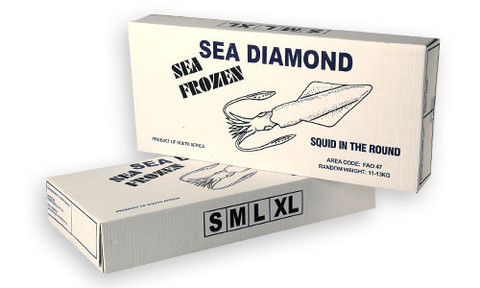Sea Diamond Squid
LOLIGO REYNAUDII
SEA FROZEN SQUID
BACKGROUND
Squid is caught in the Indian Ocean using the hand line jigging method. During the period from November to February, squid is caught mostly during the day at no more than 10 miles off shore. From March to October, squid is caught mainly at night at 10 to 20 miles off shore. Water temperature is typically 15°c – 18°c. The squid is caught, rinsed, blast frozen and placed in plastic bags on board the vessel. Squid blocks are then transported to land based cold storage on landing, where they are boxed.
Catching
The squid caught is kept in clean plastic bins and then weighed in every 4 hours at the most. The squid is kept moist with clean seawater for those 4 hours.
Sea Diamond Squid Packaging
Product and Packaging information

Weighing and Grading
The bins of squid are weighed in and then rinsed with clean seawater in order to remove all the black ink released by the squid. Each squid is then graded by length as follows:
Small 14 – 18 cm
Medium 18 – 25 cm
Large 25 – 30 cm
Extra Large 30 cm and longer
Packing and Freezing
The graded squid is then placed neatly fingerlaid in stainless steel freezer pans. A ticket containing the following information is placed with the product:
• Name of vessel and EU Code
• Production Date
• Area Code FAO 47
• Size
• Product of South Africa
The product is then placed into the blast freezer and frozen to a core temperature of -20°c within 8 to 10 hours. After this freezing period, the frozen blocks are then glazed with clean seawater before placing them into individual clear plastic bags and then put into the vessels hold where they are stored at -18°c or colder.
Land based Cold store
When the product is received at the cold store, the frozen blocks are weighed in immediately and then placed into the holding room. When the product is boxed, a quality inspection is carried out at the same time and the quality rating is displayed on each carton. CJ quality is for export. The colour of the block should be 70% reddish-brown also known as chocolate. The blocks have a random weight of between 10 to 13 kilograms. The blocks are placed into cartons that display the following information:
• The EU code of the vessel
• The date the product was boxed
• Size of product
• Quality of product
• All other regulatory information required
The final product is then placed in cold storage and stored at-20°c or colder.

